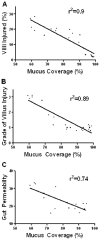Intestinal mucus layer preservation in female rats attenuates gut injury after trauma-hemorrhagic shock
- PMID: 20154538
- PMCID: PMC3024717
- DOI: 10.1097/TA.0b013e3181caa6bd
Intestinal mucus layer preservation in female rats attenuates gut injury after trauma-hemorrhagic shock
Abstract
Background: We tested the hypothesis that females are more resistant to trauma-hemorrhagic shock (T/HS)-induced gut injury than males, and this is related to better preservation of their intestinal mucus layer, which is influenced in turn by the estrus cycle stage at the time of injury.
Methods: Male, proestrus and diestrus female rats underwent a laparotomy (trauma) and 90 minutes of shock ( approximately 35 mm Hg). At 3 hours after reperfusion, terminal ileum was harvested and stained with Carnoy's Alcian Blue for mucus assessment, hematoxylin and eosin, and periodic acid schiff for villous and goblet cell morphology and injury. Ileal permeability was measured in separate intestinal segments using the ex vivo everted gut sac technique.
Results: When compared with males, proestrus female rats were significantly more resistant to T/HS-induced morphologic gut injury, as reflected in both a lower incidence of villous injury (14% vs. 22%; p < 0.05) and a lesser grade of injury (1.0 vs. 2.8; p < 0.05) as well as preservation of gut barrier function (17.9 vs. 32.2; p < 0.05). This resistance to gut injury was associated with significant preservation of the mucus layer (87% vs. 62%; p < 0.05) and was influenced by the estrus cycle stage of the female rats. There was a significant inverse correlation between mucus layer coverage and the incidence (r = 0.9; p < 0.0001) and magnitude (r = 0.89; p < 0.0001) of villous injury and gut permeability (r = 0.74; p < 0.001).
Conclusions: The resistance of female rats to T/HS-induced intestinal injury and dysfunction was associated with better preservation of the intestinal mucus barrier and was to some extent estrus cycle-dependent. Preservation of the mucus barrier may protect against shock-induced gut injury and subsequent distant organ injury by limiting the ability of luminal contents such as bacteria and digestive enzymes from coming into direct contact with the epithelium.
Figures






Similar articles
-
Relationship between disruption of the unstirred mucus layer and intestinal restitution in loss of gut barrier function after trauma hemorrhagic shock.Surgery. 2007 Apr;141(4):481-9. doi: 10.1016/j.surg.2006.10.008. Epub 2007 Jan 22. Surgery. 2007. PMID: 17383525
-
The female gender protects against pulmonary injury after trauma hemorrhagic shock.Surg Infect (Larchmt). 2001 Fall;2(3):231-40. doi: 10.1089/109629601317202713. Surg Infect (Larchmt). 2001. PMID: 12593713
-
Gut injury and gut-induced lung injury after trauma hemorrhagic shock is gender and estrus cycle specific in the rat.J Trauma. 2003 Sep;55(3):531-9. doi: 10.1097/01.TA.0000025584.46870.95. J Trauma. 2003. PMID: 14501899
-
Pancreatic duct ligation abrogates the trauma hemorrhage-induced gut barrier failure and the subsequent production of biologically active intestinal lymph.Shock. 2007 Oct;28(4):441-6. doi: 10.1097/shk.0b013e31804858f2. Shock. 2007. PMID: 17558354
-
The influence of the type of resuscitation fluid on gut injury and distant organ injury in a rat model of trauma/hemorrhagic shock.J Trauma. 2008 Aug;65(2):409-14; discussion 414-5. doi: 10.1097/TA.0b013e3181719708. J Trauma. 2008. PMID: 18695480
Cited by
-
Low doses of celecoxib attenuate gut barrier failure during experimental peritonitis.Lab Invest. 2013 Dec;93(12):1265-75. doi: 10.1038/labinvest.2013.119. Epub 2013 Oct 14. Lab Invest. 2013. PMID: 24126890 Free PMC article.
-
Loss of MLK3 signaling impedes ulcer healing by modulating MAPK signaling in mouse intestinal mucosa.Am J Physiol Gastrointest Liver Physiol. 2012 Oct 15;303(8):G951-60. doi: 10.1152/ajpgi.00158.2012. Epub 2012 Aug 23. Am J Physiol Gastrointest Liver Physiol. 2012. PMID: 22917630 Free PMC article.
-
Impaired small-bowel barrier integrity in the presence of lumenal pancreatic digestive enzymes leads to circulatory shock.Shock. 2012 Aug;38(3):262-7. doi: 10.1097/SHK.0b013e31825b1717. Shock. 2012. PMID: 22576000 Free PMC article.
-
Redefining the gut as the motor of critical illness.Trends Mol Med. 2014 Apr;20(4):214-23. doi: 10.1016/j.molmed.2013.08.004. Epub 2013 Sep 18. Trends Mol Med. 2014. PMID: 24055446 Free PMC article. Review.
-
Sexual dimorphism of cardiometabolic dysfunction: Gut microbiome in the play?Mol Metab. 2018 Sep;15:70-81. doi: 10.1016/j.molmet.2018.05.016. Epub 2018 May 30. Mol Metab. 2018. PMID: 29887245 Free PMC article. Review.
References
-
- Deitch EA, Xu DZ, Lu Q. Gut lymph hypothesis of early shock and trauma-induced multiple organ dysfunction syndrome: a new look at gut origin sepsis. J Organ Dysfunct. 2006;2:70–79.
-
- Sharpe SM, Doucet DR, Qin X, Deitch EA. Role of intestinal mucus and pancreatic proteases in the pathogenesis of trauma-hemorrhagic shock induced gut barrier failure and multiple organ dysfunction syndrome. J Organ Dysfunct. 2008;4:168–176.
-
- Specian RD, Oliver MG. Functional biology of intestinal goblet cells. Am J Physiol. 1991;260:C183–C193. - PubMed
-
- Rupani B, Caputo F, Watkins A, et al. Relationship between disruption of the unstirred mucus layer and intestinal restitution in loss of gut barrier function after trauma hemorrhagic shock. Surgery. 2004;141:481–489. - PubMed
Publication types
MeSH terms
Grants and funding
LinkOut - more resources
Full Text Sources

